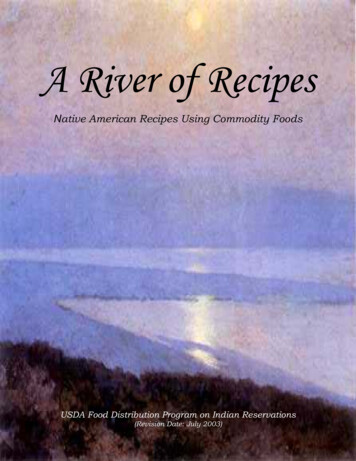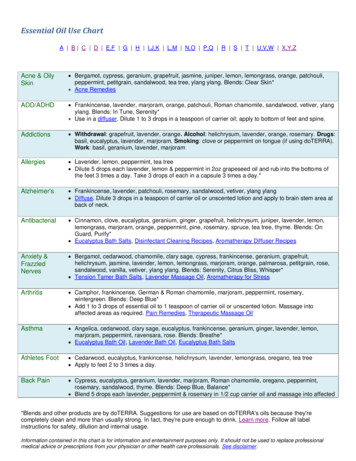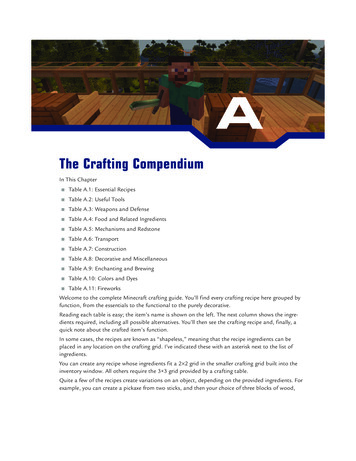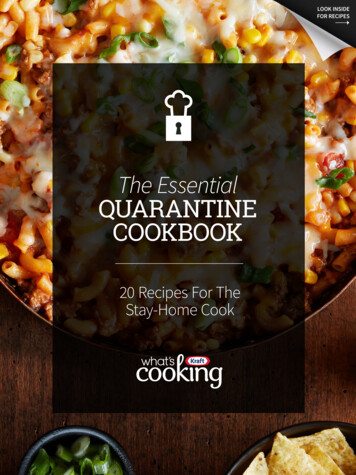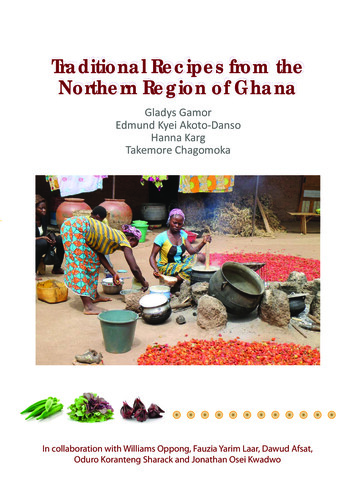
Transcription
Traditional Recipes from theNorthern Region of GhanaGladys GamorEdmund Kyei Akoto-DansoHanna KargTakemore ChagomokaIn collaboration with Williams Oppong, Fauzia Yarim Laar, Dawud Afsat,Oduro Koranteng Sharack and Jonathan Osei Kwadwo
AVRDC - The World Vegetable Center is an international nonprofit institutecommitted to alleviating poverty and malnutrition through the increasedproduction and consumption of nutritious, health-promoting vegetables. TheCenter’s improved vegetable lines and technologies help small-scale farmersboost yields, increase their incomes, and safely grow nutritious vegetables fortheir families and communities.Published byAVRDC – The World Vegetable CenterP.O. Box 42 Shanhua, Tainan 74199TaiwanT 886 6 583 7801F 886 6 583 0009E info@worldveg.orgavrdc.orgAVRDC Publication No. 15-794ISBN 92-9058-210-3Graphic Design: Vanna Liu 2015 AVRDC – The World Vegetable Center
Traditional Recipes fromthe Northern Region of GhanaGladys GamorEdmund Kyei Akoto-DansoHanna KargTakemore ChagomokaIn collaboration withWilliams Oppong, Fauzia Yarim Laar, Dawud Afsat, Oduro Koranteng Sharack and Jonathan Osei KwadwoAVRDC - The World Vegetable Center
ForewordMalnutrition remains a global problem, with women and children the worstaffected, particularly in sub-Saharan Africa. During the Second InternationalConference on Nutrition (ICN2) in 2014, dietary diversity was among therecommended approaches to address all forms of malnutrition. Variousindices of dietary diversity, including Women’s Dietary Diversity Scores,are good proxies of household dietary diversity and household nutrientadequacy.Traditional knowledge on the use of diverse plant species, including how toprepare these plants for consumption, forms a critical base for householddietary diversity. Vegetables are a cheap and sustainable source of muchneeded micronutrients for human health, and are an integral part ofagricultural biodiversity. As increasing numbers of people migrate to Africa’scities, urban poverty is on the rise and levels of wasting and stunting havesoared, especially among children under five. Traditional knowledge onhow to grow and prepare nutritious vegetables such as amaranth is oftenlost when people move from rural to urban areas. Preparation methodsand different combinations of food can improve consumption and uptake ofmicronutrients.The recipes in this book were collected and documented under theUrbanFoodPlus project financially supported by the Federal Ministry ofEducation and Research (BMBF). UrbanFoodPlus is an African-Germanpartnership seeking to enhance resource use efficiency of urban andperiurban agriculture and improve food security in West African cities.AVRDC – The World Vegetable Center is a partner in the UrbanFoodPlusproject. This book was prepared in collaboration with the Department ofFamily and Consumer Sciences of the University for Development Studiesbased in Tamale, Ghana.This work was inspired by two studies carried out in and around Tamaleunder UrbanFoodPlus: A food flow study focused on the movement andsupply of food in and out of Tamale, and a food and nutrition study whichexplored the dynamics of household food and nutrition insecurity and theimplication of agriculture along the urban - rural continuum.J.D.H. KeatingeDirector GeneralAVRDC – The World Vegetable Center
ContentsIntroduction6Acknowledgements7About the recipes8ONE-POT DISHES9Tubaani (steamed cowpea pudding)10Dawadawa jollof with Guinea fowl14Spaghetti (pasta) jollof15Yam pottage16ACCOMPANIMENTS17TZ18Rice balls19Banku20Fried yam21Waakye (rice and beans)22Boiled pigeon pea23MAIN DISHES (SOUPS AND STEWS)24Fish groundnut soup25Fish bra leaves soup26Fish jute mallow leaves soup28Fish okra (dry) soup29Fish okra (fresh) soup30Fish baobab (dry) leaves soup31Fish okra stew32Amaranth leaves stew33Shito34DRINKS35Tamarind drink36Sobolo drink (Roselle calyx drink)37SNACK38Roasted groundnut39Koose (fried cowpea bean cake)40Porridge41Corn dough flour porridge41Spiced corn dough porridge41Spiced sorghum dough porridge41Spiced millet flour porridge41
IntroductionThe Northern Region is the largest region in Ghana withTamale as the regional administrative and economiccentre. The northern part of Ghana is situated in theGuinea Savannah agro-ecological zone of West Africa. Cropproduction in this zone is highly dependent on seasonalclimatic patterns. Whereas staple food crop productionflourishes during the rainy season, dry season cultivation islimited due to the lack of water sources for irrigation.Most people, particularly in the rural areas, are subsistencefarmers and source a large share of food from their own rainfed production. They grow cereals such as maize, millet andsorghum, legumes (groundnut, bean, cowpea, pigeon pea,lately soya bean) and a variety of vegetables (hot pepper,tomato, onion, garden egg and dark green leafyThe Northern Region and itscapital Tamalevegetables) which are used in the preparation of soup andstews.Livestock keeping is common and many urban and rural households rear cows, goats, sheepand poultry (chicken, guinea fowl, ducks, and turkeys). However, these do not form partof the daily meal but are mainly eaten on festive and special social or religious occasions.Consequently, protein consumption is usually from plant sources, especially among the ruralor poor households that cannot afford animal protein. Fresh fish from freshwater sources, ordried fish such as smoked anchovies from the southern part of the country pounded as fishpowder, also provide animal protein in household meals.As part of our PhD research, we have been studying rural-urban food flows, householdfood and nutrition insecurity, and the role played by urban and periurban agriculture infeeding urban dwellers in Tamale. This incited our curiosity to find out to what extent certainagricultural goods actually contribute to food security in terms of calorie, vitamin andnutrient intake. Therefore, we needed to know what people were eating in their homes aswell as outside, and how homemade food is being prepared.To do this, eating patterns of twelve randomly selected households in urban, periurban andrural areas of Tamale were recorded. These food diaries consisted of the meals eaten by theindividual households (either cooked at home or bought). The households were visited fora few days during the peak season of 2014 as well as the lean season of 2015. All foodstuffand ingredients were weighed and the food preparation processes recorded so as to depictthe way such food is prepared in the region. To confirm the food preparation processes,the meals were cooked by members of the Department of Family and Consumer Sciences,University for Development Studies, Tamale, Ghana.6
AcknowledgementsWe would like to thank the individuals and institutions who in one way or anothercontributed to the collection and compilation of the recipes in this book. This work wasdone under the UrbanFoodPlus project funded by the BMBF (http://www.urbanfoodplus.org). Our gratitude goes to Williams Oppong, Fauzia Yarim Laar, Dawud Afsat, OduroKoranteng Shadrack and Jonathan Osei Kwadwo for contributing to data collection andpreparing the meals.We would especially like to recognize the efforts of Dr. Pay Drechsel of the InternationalWater Management Institute for his financial support.We are grateful to Ophelia Soliku (University of Freiburg, Germany) and Jasmin Marston(University of Freiburg, Germany) for providing useful insights and review in thedevelopment of this book, and to Vanna Liu for the book design and layout.7
About the recipesThe meals in this recipe book are designed to serve four persons. As much as possible,references to time are avoided as different sources of heat and hence temperatures mightbe used. Measurements are given in grams and millilitres where possible. Tea and tablespoon measurements used were levelled, not heaped. One teaspoon is on average 6 ml(liquid), 5 g (dry) and 1 tablespoon is on average 15 ml (liquid), 15 g (dry).The book covers the meals that were recorded in the food diaries, which included:ONE-POT DISHES - tubaani (steamed cowpea pudding), dawadawa jollof and macaroni(spaghetti or pasta) jollof and yam pottageACCOMPANIMENTS - TZ, rice balls, banku, fried yam, waakye and pigeon peaMAIN DISHES (SOUPS AND STEWS) - fish groundnut soup, fish bra leaves soup, fish jutemallow leaves soup, fish okra (dry) soup, fish okra (fresh) soup, fish baobab (dry) leavessoup, fish okra stew, amaranth leaves stew and shitoDRINKS - puha and sobolo (roselle calyx drink)SNACKS - roasted groundnut, koose (fried cowpea bean cake), kulikuli (fried groundnutresidue rings)List of vegetables/meals and their English or scientific akye8Amaranthus cruentusCorchorus olitoriousHibiscus cannabinusExotic Xylopia aethopicaAfrican locust bean (Parkia biglobosa)Arachis hypogaeaAfrican Xylopia aethopicaFried cowpea (bean) cakeFried groundnut residue ringsAdansonia digitataAbelmoschus esculentusTamarindus indicaRoselle calyx drinkSolanum lycopersicumSteamed cowpea (Vigna unguiculata) puddingTuo ZaafiRice and Beans (boiled)
Tubaani in a saucepan with leaves forming a base, and to cover the waterONE-POT DISHES9
Tubaani (steamed cowpea pudding)Ingredients 800 g cowpea flour 6500 ml waterPreparation Mix water with cowpea flour and beat in circular motion untilmixture is fluffy Wash leaves (people usually use Thaumatococcus daniellii leafor banana leaf or corn husk) and wrap a small portion of themixture in each Boil water on a separate fireCooking Put (enough) water on fire and cover Place some of the (empty) leaves in the sauce pan to form abase and then again on top to cover the water Put the wrapped mixture on the leaves in the boiling water,cover and steam for about 2 hours Occasionally add hot/boiling water, pouring around the sidesof the saucepan to prevent burning Continue to steam until cooked Take off fire, unwrap and slice Serve hot with tomato sauce or spiced groundnut powderand vegetable oil (200 ml oil fried with 50 g onion and half ateaspoon powdered hot pepper)10
Tomato sauce for TubaaniIngredients 280 ml oil 140 g onions 200 g tomatoes 50 g tomato paste 20 g hot pepper 50 g powdered fish 10 g bouillon tablet 20 g ginger 500 ml water Salt to tastePreparation Chop onion Grind tomatoes, hot pepper and ginger Pound dry fishCooking Heat oil Add chopped onions and allow to fry Add ground vegetables and tomato paste Add salt to taste, stir and allow to simmer Crush in bouillon tablet and add fish powder Cover and allow to simmer until cooked Serve with Tubaani11
Spaghetti (pasta) jollofIngredients 100 ml oil 350 g spaghetti (pasta) 200 g tomatoes 25 g dawadawa 150 g onions 50 g powdered fish (amani) 15 g hot pepper 10 g bouillon tablet 1000 ml water Salt to tastePreparation Grind vegetables together Pound or crush dawadawa Break spaghetti into desirable pieces Chop onion Pound dry fishCooking Heat oil Add chopped onions, tomatoes and pounded dawadawa Allow to cook and add enough water to boil Add broken spaghetti Stir to prevent sticking together Cover and allow to cook Stir occasionally with wooden spoon until soft and all liquid issoaked up Serve hot12
13
Dawadawa jollof with Guinea fowlJollofIngredients 600 g local rice 50 g dawadawa 50 g fish powder (optional) 120 g fresh onion 320 g fresh tomato 50 g tomato paste 20 g fresh hot pepper 20 g ground ginger 500 ml vegetable oil 1500 ml waterPreparation Slice onion Grind tomatoes, hot pepper and ginger Remove stones and foreign materials from rice and wash Pound or crush dawadawaCooking Put oil on fire and allow to heat Add onion to hot oil and allow to fry until cooked/slightlybrown Add ground vegetables (tomato, ginger, hot pepper and onion) Add tomato paste and pounded or crushed dawadawa and stir Allow to simmer until cooked Add water and salt to taste Allow to boil Add rice, stir and allow to boil until cooked Serve hot with fried guinea fowlRemarksDawadawa, a condiment, serves as a meat or protein source whenthere is no animal source of meat. Traditionally, shea butter is usedinstead of vegetable (cooking) oil.14
Spaghetti (pasta) jollofGuinea FowlIngredients 380 g guinea fowl meat 500 ml vegetable oil 20 g ground ginger 10 g bouillon tablet 20 g sliced onion Salt to tastePreparation Cut guinea fowl into pieces Grind ginger and onion Season meat with groundvegetables and bouillon tabletand allow to stand for 20 minutesCooking Boil seasoned meat until tender Put oil on fire and allow to heat Deodorize the oil by frying onion in it Fry guinea fowl pieces in hot oil inportions Turn occasionally to avoid burning When cooked, remove meat from oiland place in a colander to drain15
Yam pottageIngredients 730 g yam 120 g fresh onion 160 g fresh tomatoes 200 ml palm oil 50 g fish powder (amani) 17 g hot pepper 10 g bouillon tablet 30 g tomato paste 1050 ml water Salt to tastePreparation Wash and peel yam and cut into cubes Grind tomato, onion and hot pepper Pound dry fishCooking Put yam cubes into saucepan and add water Put on fire to boil Add salt, ground vegetables, tomato paste and fish powder Allow to cook until yam is soft Use spoon to mash yam against sauce pan for thickeningconsistency Add palm oil Allow to cook, add chopped onion and allow to simmer Serve when cookedRemarksTo enhance the taste and nutritional content, non-slimy leafyvegetables can be added.16
Some common cooking utensils used in food preparationACCOMPANIMENTS17
TZ (Tuo Zaafi)Ingredients for whole meal500 g corn flour (whole meal)150 g cassava flour4250 ml waterIngredients for dehusked meal450 g corn flour (dehusked)300 g cassava flour3500 ml waterPreparationMix 1/3 corn flour with enough waterMix remaining corn flour with cassava flourCooking Put water on fire to boil Add the mixture of corn flour with enough water and stir Cover and allow to boil and stir occasionally to prepareporridge Add more water if too thick Fetch 1/3 of porridge and keep aside Add corn/cassava flour mixture in bits by sprinkling toporridge on fire Stir vigorously to avoid lump formation If too thick add the set-aside porridge, a little at a time Stir (work) against pot to break lumps until cookedServe with bra, baobab, ayoyo leaves, okra or groundnut soup18
Rice ballsIngredients 800 g rice 3000 ml waterPreparation Pick foreign materials from rice and washCooking Put water to boil Add rice, stir and cover Cook rice, adding more water in small amounts until rice isvery soft Stir against pot to break rice grains Cover and allow to cook well Stir and mould into balls Serve hot with soupServe with groundnut soup19
BankuIngredients 1000 g cassava dough 1300 g corn dough 2 tablespoons of salt 4000 ml waterPreparation Mash corn and cassava dough together with water Add salt to tasteCooking Put mixture on fire and stir gently until mixture thickens Stir very well to break lumps into a smooth paste Add water (if too hard), cover and allow to boil for a fewminutes Continue stirring until the food is cooked and the desiredtexture is acquired Mould into balls and serveServe with groundnut soup, okra soup, okra stew, aleefu stew,or bra soup20
Fried yamIngredients 850 g sliced yam 2 teaspoons of salt 1500 ml waterPreparation Wash, peel and cut yam into eatable pieces Wash peeled yam (again) Add washed yam pieces to salt water (2 tablespoon of salt in1500 ml of water) and allow to stand for three minutesCooking Heat oil Deep fry yam in bits Turn occasionally to cook evenly and to avoid burning Fry yam until crispy and cooked Serve hot with spiced groundnut powder, a little frying oiland/ or hot pepper sauce (15 g fresh hot pepper, 75 g onion,65 g tomato ground together with salt to taste)21
Waakye (rice and beans)Ingredients 1000 g rice (unpolished or polished) 500 g cowpeas (black-eye) 50 g sorghum leaf stalk 5 g saltpetre (potash) – optional 4000 ml water Salt to tastePreparation Pick foreign materials from the cowpea and wash Pick foreign materials from rice and wash to remove stonesand dirt (if unpolished) Wash sorghum leaf stalkCooking Put water to boil Add sorghum leaf stalk and saltpetre Add cowpea to mixture Allow to boil until cowpeas are half cooked, add rice and stirto mix Add salt to taste and stir Allow mixture to boil until cooked Serve hotRemarks:Sorghum leaf stalk is added to extract its reddish brown colour, whichmakes the food look bright and also tasty.Sauce for waakyeIngredients 100 ml vegetable oil 120 g onion 230 g tomatoes 15 g hot pepper 200 g water22 Salt to taste20 g fish powder30 g tomato paste13 g ginger10 g bouillon cube
Preparation Slice onion Wash and grind tomatoes, hot pepper and ginger Pound dry fishCooking Heat oil and add sliced onions to fry Add ground vegetables and allow to boil Add tomato paste, stir and allow to simmer Add bouillon tablet, fish powder and salt Stir to mix evenly Cover and allow to simmer over low heat to cook further Add chopped onions and allow to cook for 2 minutes and takeoff fireBoiled pigeon peaScientific name: Cajanus cajanLocal name(s): AduaIngredients 430 g pigeon peasSalt (to taste)Hot pepper (to taste)Onion (optional) Ground ginger (optional)Saltpetre (optional)16500 ml water200 g gari (optional)Preparation Pick foreign materials from the pigeon peas and wash Soak pigeon peas in water overnight to soften and cook faster(optional)Cooking Put water on fire and add pigeon peas to boil Continue to boil, adding water until tender and cooked Add saltpetre to aid softening and reduce cooking time(optional) Allow it to boil until pigeon peas are cooked, add salt(1 teaspoon) Serve boiled pigeon peas with fried oil (100 ml palm oil friedwith 30 g sliced onion) and gariRemarksAmount of cooking water and time will be reduced if a pressurecooker is used.23
Preparation of groundnut soup at homeMAIN DISHES(SOUPS AND STEWS)24
GroundnutScientific names: Arachis hypogaeaCommon names:Local names: Sima (Northern Region), sikaa (Upper East), siimie,jenii (Upper West)Fish groundnut soupIngredients 300 g groundnut paste 100 g onion 10 g hot pepper 130 g tomato 100 g smoked fish 30 g fish powder 30 g ginger 10 g bouillon tablet 3000 ml water Salt to tastePreparation Mix groundnut paste with water and mash Grind tomatoes, hot pepper, ginger and onion Wash smoked fish, remove waste and bones Break fish into eatable/edible pieces Pound dry fishCooking Put groundnut paste mixture on fire and simmer until oilappears while stirring occasionally Add enough water of about 2000 ml and allow to boil for 1015 minutes Add ground vegetables and allow to boil Add both pounded, smoked fish and crushed bouillon tabletinto soup Add salt to taste Allow to boil until soup is cookedServe with tuo zaafi, banku, kenkey, eba, fufu (pounded yam,cocoyam, cassava or plantain)25
KenafScientific names: Hibiscus cannabinusLocal names: Bra, bito (Upper East), bri, bre (Upper West)Fish bra leaves soupIngredients 200 g bra leaves 300 g groundnut paste 130 g raw groundnuts 200 g tomato 80 g dry okra 50 g fish powder 60 g dawadawa 15 g hot pepper 180 g onion 10 g bouillon tablet Salt (to wash bra leaves and for soup to taste) 3500 ml waterPreparation Remove bad fish, fish heads and foreign material or dirt fromthe lot Pound the fish Scrape ginger, rinse in clean water and grind Sort raw groundnut Sort bra leaves, clean and wash with 30 g of salt water mixtureand cut into desirable pieces Pound dawadawa Grind hot pepper with tomatoes Pound okra (rough texture) Slice onionCooking Method 1: Mix groundnut paste with enough water to make amixture of light consistency, simmer until oil comes out, stirringoccasionally26
Method 2: Put water on fire to boil, add groundnut paste andstir to mix; boil until oil comes out Add ground tomatoes and hot pepper Add pounded dawadawa and fish Add crushed bouillon tablet and allow to boil Add pounded raw groundnut and okra Add 1 tablespoon of ground ginger (optional) Add salt to taste and allow to boil until well cooked Add cut kenaf leaves, stir and allow to boil for a few minutes Bring off fire and serveServe with tuo zaafi, banku or rice balls.RemarksInstead of bra, one can use aleefu or any local dark green leafyvegetable (not slimy). Dawadawa is a local condiment made fromfermented decorticated African locust bean (Parkia biglobosa)seeds. It is widely used in rural northern Ghana in stew and souppreparations to improve the taste and aroma of the food. It isnutritious; unfortunately, it is being neglected by the urban elite andgradually by some people in the rural areas because of its pungentsmell.27
Jute MallowScientific names: Corchorus olitorius L., C. tridens L., C.trilocularis L.Common names: Jute mallowLocal names: Ayoyo, Fotsolo, Fontsolo (Upper West)Fish jute mallow leaves soup (Fish Ayoyo Soup)Ingredients 300 g jute mallow leaves 50 g dawadawa 150 g fresh tomato 15 g fresh hot pepper 100 g onion 50 g fish powder 10 g bouillon tablet Saltpetre 1000 ml water Salt to tastePreparation Wash jute mallow with 30 g salt added to water (brine) Chop/pound jute mallow Grind hot pepper (dry or fresh) and tomatoes Chop onion into pieces Pound dawadawa Pound dry fishCooking Put water on fire to boil Add pounded dawadawa and allow to boil Add ground tomatoes and hot pepper Add powdered hot pepper and chopped onion and allow to boil In a separate pot, steam jute mallow with little water Add saltpetre to make it slimy and steam for about 5-10 minutes Add steamed jute mallow to the mixture Add salt to taste Add water (if too thick) and allow mixture to boil Serve when cookedServe with tuo zaafi, banku, kenkey or ebaRemarksMeat and/or any suitable protein source can be used. Palm or any othervegetable oil can also be added.28
OkraScientific names: Abelmoschus callei, A. esculentusCommon names: Okra, Lady’s fingersLocal names: Mana (Northern Region), nkruma (Twi), maana(Upper East), saalu, maani (Upper West)Fish okra (dry) soupIngredients 80 g dry okra 50 g dawadawa 60 g fresh tomato 120 g fresh onion 15 g fresh hot pepper 1 bouillon tablet 50 g powdered fish Dry onion leaves (gabo) 1500 ml of water Salt to tastePreparation Boil water Slice onions Pound dry onion leaves (gabo) Pound fish Grind tomatoes and hot pepper Pound dry okraCooking Put water on fire to boil Add pounded dawadawa Add fish powder and bouillon tablet and allow to boil Add sliced onions and ground vegetables Add water and allow to boil Add pounded dry okra in bits (sprinkling) while stirring toavoid lump formation Add pounded dry onion leaves (gabo) - optional Allow to boil for a few minutes and take off fireRemarksGabo (dry onion leaves) is a local flavouring added to the food toimprove aroma and taste.29
Fish okra (fresh) soupIngredients 120 g okra 100 g onion 15 g fresh hot pepper 10 g of bouillon tablet 30 g powdered fish 50 g smoked fish 100 ml palm oil 5 g saltpetre 500 ml water Salt to tastePreparation Wash and cut okra into pieces Pound okra with saltpetre in a mortar or beat in a bowl with akitchen spoon until slimy Wash fish, remove bones, and waste and break into pieces Chop onions Grind tomatoes and hot pepper Pound dry fishCooking Put oil on fire Add chopped onions to oil and allow to fry Add ground vegetables Add powdered fish Add bouillon tablet and water Cover and allow to boil Add salt to taste Add beaten or pounded okra Allow to boil for a few minutes and bring off fireServe with tuo zaafi, banku or kenkey30
BaobabScientific names: Adansonia digitataCommon names:Local names: Kuuka (Hausa), tukari (Northern Region), tukaara(Upper East Region), tokura zon, tukuru koomo (Upper WestRegion)Fish baobab (dry) leaves soupIngredients 75 g dry baobab leaves powder (kuuka) 50 g dawadawa 50 g fish powder 15 g fresh hot pepper 120 g fresh onion 160 g fresh tomato 10 g bouillon tablet 50 g tomato paste 100 ml palm oil 500 ml water Salt to tastePreparation Grind tomato, onion and hot pepper Chop onion Pound dry fish Pound dawadawaCooking Put palm oil on fire and allow to heat Add chopped onions to hot oil and allow to fry until onionsare cooked Add ground vegetables Add bouillon tablet and water Allow to boil Add fish powder and salt Add water, stir, cover and allow to boil until cooked Sprinkle baobab leaf (kuuka) powder in bits and stir to avoidlump formation Cover and allow to boil until cooked31
Fish okra stewIngredients 220 g okra200 g garden eggs50 g palm oil130 g fresh tomato15 g fresh hot pepper75 g smoked fish30 g fish powder150 g onion10 g bouillon tablet90 g meat (optional)10 g ginger500 ml waterSalt to tastePreparation Wash and cut garden eggs and okra into pieces Wash fish, remove bones and waste, and break into pieces Chop onions Grind tomatoes, hot pepper, onions and gingerCooking Put oil on fire to heat Add chopped onions to fry Add ground vegetables Add smoked fish and bouillon tablet and a little water Cover and allow to boil Add salt to taste, stir and add cut garden eggs Add cut okra and stir when garden eggs are half-cooked Add chopped onions and allow to cook Remove from fire and serveServe with banku, eba, kenkey32
AmaranthScientific names: Amaranthus cruentus L., A. lividus, A. dubiusCommon names: AmaranthLocal names: Aleefu, aleefiAmaranth leaves stewIngredients 550 g amaranth leaves 430 g tomatoes 200 g onion 70 g tomato paste 15 g hot pepper 50 g fish powder 250 g agushi (melon seed)10 g bouillon tablet15 g ginger10 g garlic (fresh)2700 ml waterSalt to tastePreparation Sort aleefu leaves, clean and wash with 30 g of salt water(brine) Cut leaves into pieces and blanch Wash and grind hot pepper and tomatoes Scrape ginger, rinse in clean water and grind Slice onion Grind the agushi into a soft paste (or dry)Cooking Put palm oil on fire to heat Add onion and allow to fry Add ground tomatoes and hot pepper Add tomato paste, stir and let it boil Stir, cover and allow to simmer Add bouillon tablet and salt to taste Add agushi, to form lumps and cook without stirring Stir to mix evenly after lumps formation Add blanched amaranth leaves, stir and allow to simmer for afew minutes Bring off fire and serveServe with plain boiled rice, boiled yam, banku or kenkeyRemarksMeat and/or fish can be substituted for fish powder. Wash allvegetables, especially leafy greens, with enough water until clean,preferably three times; add salt to the last washing water.33
ShitoIngredients 300 ml vegetable oil 140 g fresh onion 250 g fresh tomatoes 50 g dry whole hot pepper 40 g ginger 50 g fish powder 10 g bouillon tablet 200 ml water Salt to tastePreparation Pound dry hot pepper together with fresh ginger Pound dry fish Grind tomatoes and hot pepper Chop onionCooking Heat oil Add chopped onions and tomatoes Cover and allow to cook Add ground vegetables, salt and bouillon tablet Cover and allow to cook further until all water has evaporated Add pounded hot pepper, stir, cover and allow to cook Add fish powder and continue stirring to avoid burning Cook until sauce is dark brown in colour Take off the heat and serve34
Sieving sobolo drinkDRINKS35
TamarindScientific names: Adansonia digitataCommon names: TamarindLocal names: Puha, tankwa bia, puhe, puhi (Upper West) Saamia(Hausa)Tamarind DrinkIngredients 200 g tamarind seed (peeled including seeds) 2500 ml water 80 g ginger 3 g alligator pepper 5 g cloves Sugar to tastePreparation Scrape and wash ginger Wash and grind all spices Soak tamarind overnight (optional)Cooking Boil water and pour over tamarind Soak for several hours (or overnight) Mash the mixture for the pulp to come off the seeds Add ground spices Add more water (3000 ml) and put to boil for 30 minutes Put off fire and allow to cool Sieve and strain to get rid of particles (spices and pulp) Sweeten to taste and serve chilled36
RoselleScientific names: Hibiscus sabdariffaCommon names: Roselle, sorrelLocal names: Bra, suure soboloSobolo Drink (Roselle Calyx Drink)Ingredients 100 g roselle calyces (dry) 40 g fresh ginger 5 g hwentia (African Xylopia aethopica) 5 g cloves (exotic Xylopia aethopica) 300 g sugar 4400 ml water (400 ml used to mix spices after grinding)Preparation Pick foreign items from the sorrel leaves Wash and scrape ginger Grind spices – ginger, hwentia and clovesCooking Boil roselle calyx with ground spices (method 1) Boil water and pour over roselle calyces and leave to stand for45 minutes (or overnight) Add ground spices and stir to mix well (method 2) Cover and leave to stand until colour is extracted Leave mixture to cool Strain liquid and sweeten to taste (common sweeteners –sugar, honey or fruit juice) Add flavouring (optional) Serve chilled37
Different snacks served with porridge.Top left: spiced sorghum porridge. Top right: spiced millet porridge. Bottom left:spiced corn dough porridge. Bottom right: corn dough porridge.SNACKS38
Roasted groundnutsIngredients 300 g groundnuts 2 tablespoons salt 550 ml water Sea/river sandPreparation Sort fresh groundnuts and remove foreign materials,stones or dirt Sort to have even sizes Sieve and wash sand to clean the sandCooking Put water (enough) in saucepan and add salt Cover and allow to boil Add groundnuts and allow to boil for 2 minutes Strain water off. Spread out and leave in the sun to dry Heat pot with river sand (ensure the sand is hot enough) Pour in the dried groundnuts and stir (to roast) Stir occas
AVRDC - The World Vegetable Center is an international nonprofit institute committed to alleviating poverty and malnutrition through the increased . production and consumption of nutritious, health-promoting vegetables. . The book covers the meals that were recorded in the food diaries, whi


